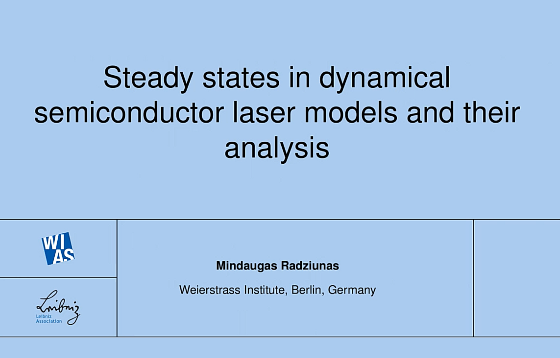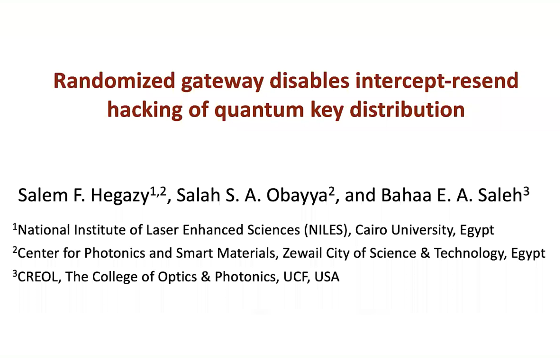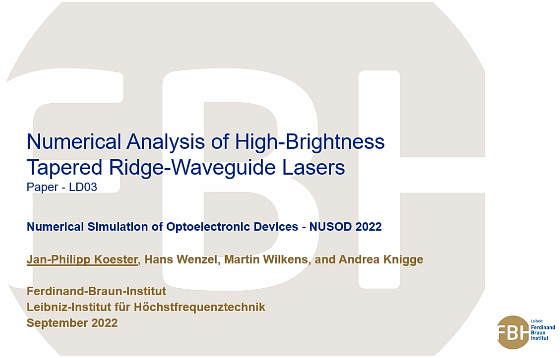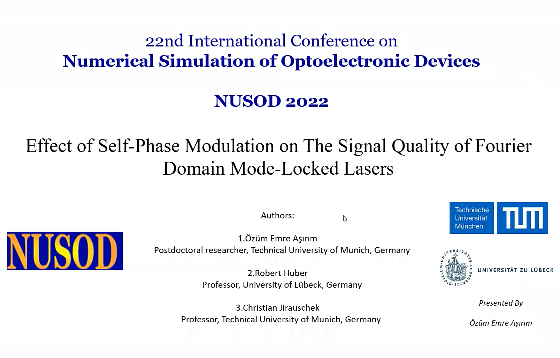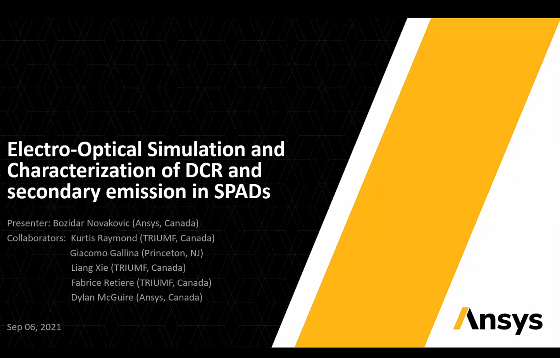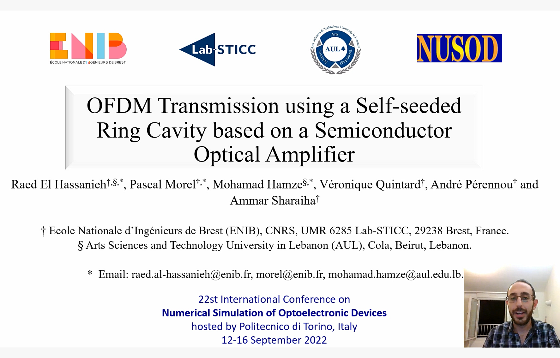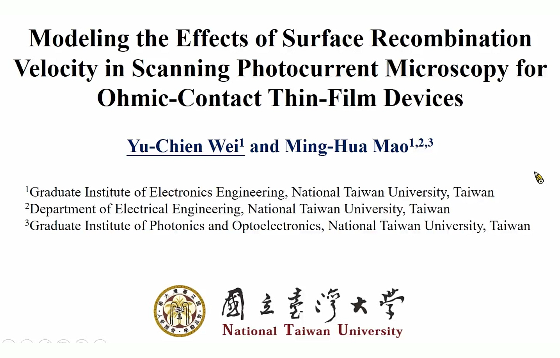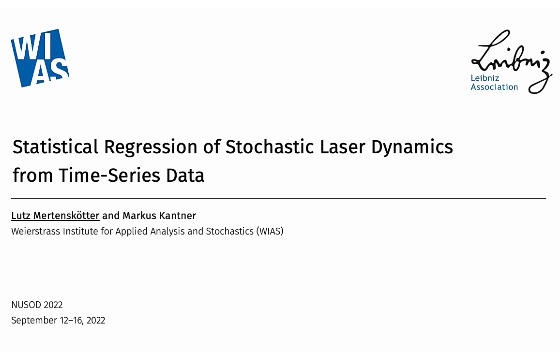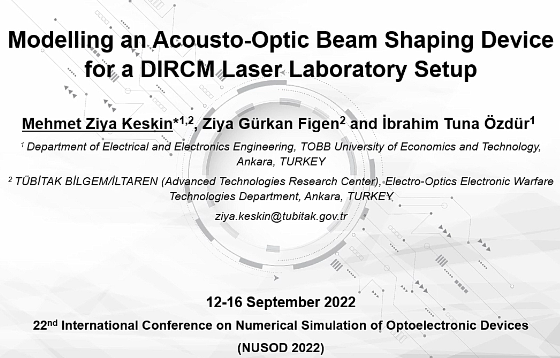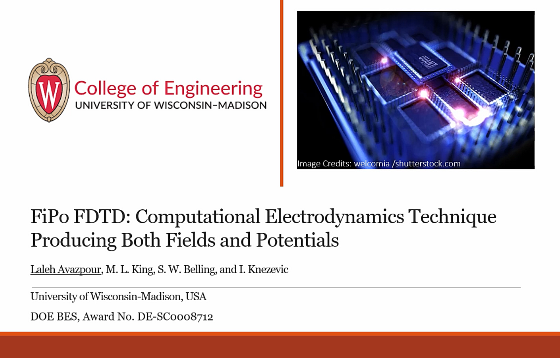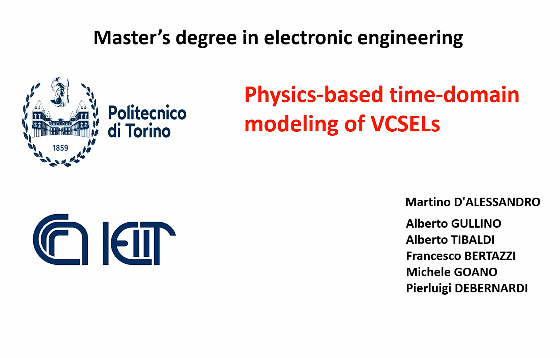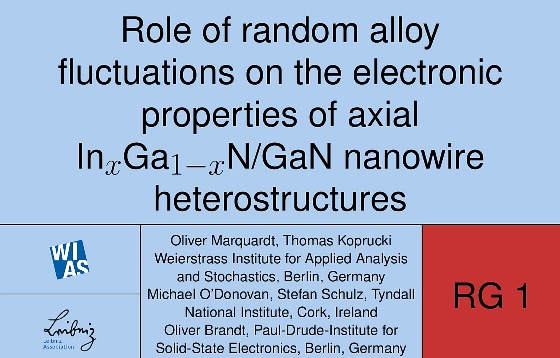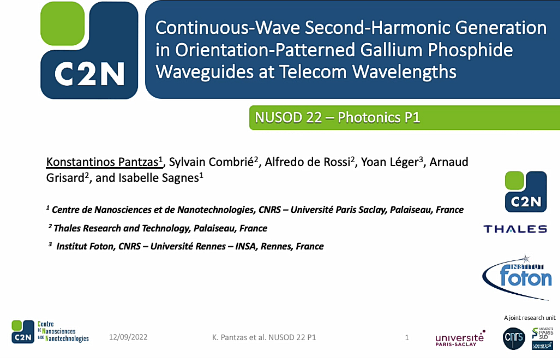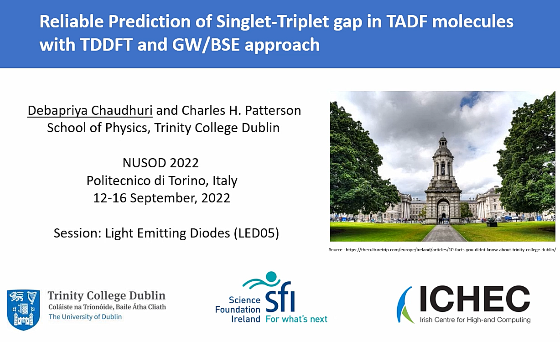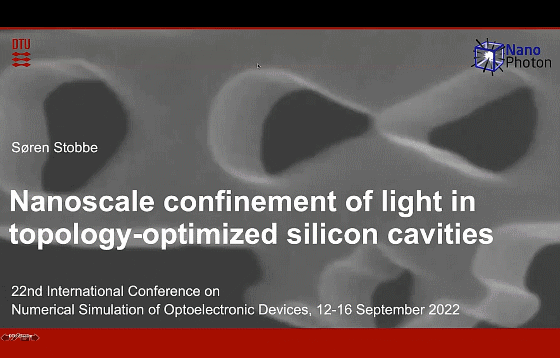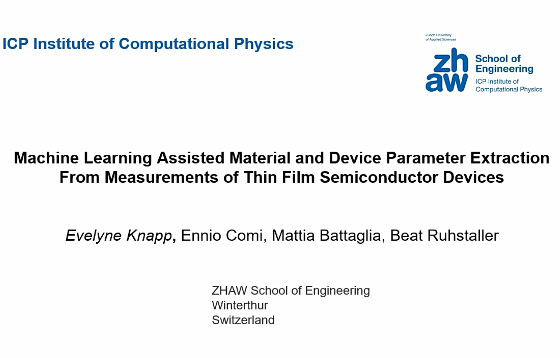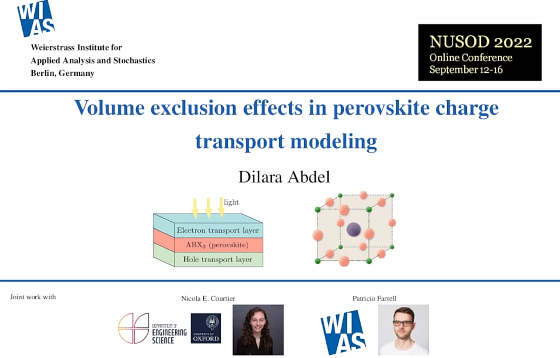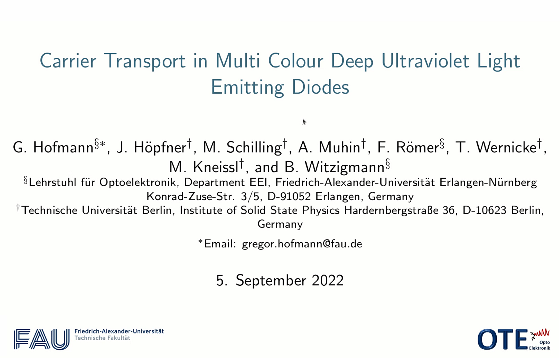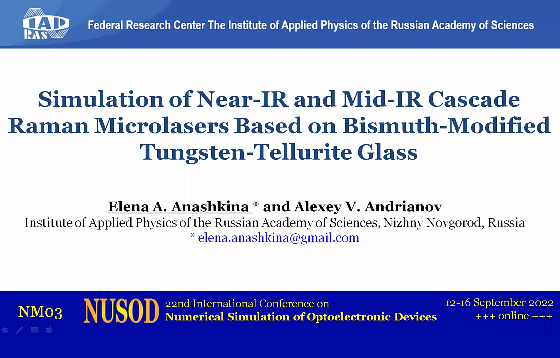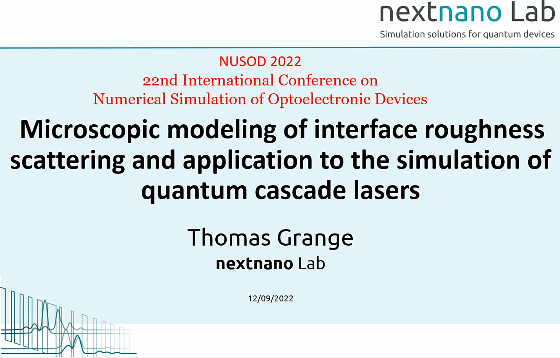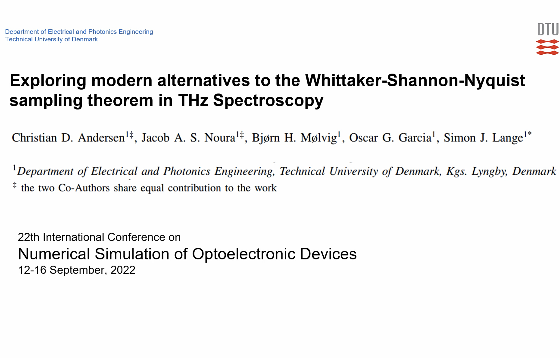Oral51 Videos



We present an algorithm for calculating steady states in the dynamic PDE model for SLs admitting gain compression, spatial hole burning, and multilevel carrier rate equations. Presented example simulations rely on 1(time)+1(space)-dimensional traveling-wave- and Lang-Kobayashi-type models.
IS03 – Polarization-randomized gateway against detector-blinding hacks of quantum key distribution
A quantum key distribution system –employing a key time-bin qubit and a security-pass polarization-randomized qubit– is shown to overcome a wide class of intercept-resend attacks adopting the use of faked-state light; including attacks based on blinding of single-photon avalanche detectors (SPADs).
LD03 – Numerical Analysis of High-Brightness Tapered Ridge-Waveguide Lasers
In this work, we present a simulation-based analysis of a CW driven tapered ridge-waveguide laser having a high lateral brightness of 5 W · mm−1mrad−1 at 2.5 W optical output power.
LD10 – Effect of Self-Phase Modulation on The Signal Quality of Fourier Domain Mode-Locked Lasers
In this paper, the impact of self-phase modulation on the noise performance of Fourier Domain Mode-Locked (FDML) lasers is investigated. It is shown that under a relatively high fiber nonlinearity and/or intracavity signal amplitude, an excess amount of noise generation occurs, which can not only lead to poor signal quality, but also operational instability. Hence, […]
D02 – Electro-Optical Simulation and Characterization of DCR and secondary emission in SPADs
We demonstrate the use of simulations in the modeling and characterization of important aspects of Single Photon Avalanche Detectors (SPADs). Electrically, we discuss the use of drift-diffusion and avalanche triggering probability solvers and results for dark count rate (DCR) and their comparison to measurements. Optically, we discuss the use of full wave electromagnetic solvers to […]
IS07 – OFDM Transmission using a Self-seeded ring Cavity based on a Semiconductor Optical Amplifier
This paper discusses the transmission of optical Orthogonal Frequency-Division Multiplexing (OFDM) format modulation in a resonant cavity based on a Semiconductor Optical Amplifiers Fiber Cavity Laser (SOA-FCL). The OFDM Subcarriers are configured and transmitted to fit the Cavity Resonance Modes (CRM). As a result, the authors show a novel principle of OFDM transmission in a […]
NM05 – Modeling the Effects of Surface Recombination Velocity in Scanning Photocurrent Microscopy for Ohmic-Contact Thin-Film Devices
We studied numerically the carrier transport and confirmed the feasibility of our scanning photocurrent microscopy model in the minority carrier decay length extraction under different surface recombination velocities at the surfaces of ohmic-contact thin-film devices.
LD05 – Data-Driven Modeling of Non-Markovian Noise in Semiconductor Lasers
Non-Markovian noise degrades the coherence properties of semiconductor lasers and contributes significantly to broadening of the linewidth. Since modeling of such colored noise systems from first principles is not accessible, we aim for a data-driven modeling approach in which a system of stochastic rate equations shall be reconstructed from time series data.
NM06 – Modelling an Acousto-Optic Beam Shaping Device for a DIRCM Laser Laboratory Setup
Directed Infrared Counter Measure (DIRCM) laser laboratory setups are used to mimic the real life DIRCM system and IR heat-seeking missile engagement scenarios in isolated laboratory environments. Typically, the output beam of a mid-infrared (Mid-IR) laser source is modulated in time using an acousto-optic (AO) modulator (AOM). Following the AOM in the optical path, within […]
MM09 – FiPo FDTD: Computational Electrodynamics Technique Producing Both Fields and Potentials
We present the field–potential finite-difference time-domain (FiPo FDTD) algorithm, which solves a set of first-order equations for the electric and magnetic fields (E and H), as well as the magnetic vector potential A and the scalar electric potential φ in the Lorenz gauge. We also present the derivation and implementation of a convolutional perfectly matched […]
LD07 – Physics-based time-domain modeling of VCSELs
This paper presents the results of a physics-based time-domain simulator for a vertical-cavity surface-emitting laser (VCSEL). We implemented a trapezoidal rule second order backward differentiation formula (TR-BDF2) to simulate the large signal response of the device under investigation, including the parasitic effects of the pin junction arising from an interplay of optical and carrier transport […]
N02 – Influence of random alloy fluctuations on the electronic properties of axial In(x)Ga(1−x)N/GaN nanowire heterostructures
Compound semiconductor heterostructures such as quantum dots, nanowires, or thin films, are commonly subject to randomly fluctuating alloy compositions if they contain ternary and quaternary alloys. These effects are obviously of an atomistic nature and thus rarely considered in heterostructure designs that require simulations on a continuum level for theory-guided design or interpretation of observations. […]
P01 – Continuous-Wave Second-Harmonic Generation in Orientation-Patterned Gallium Phosphide Waveguides at Telecom Wavelengths
A new process to produce Orientation-Patterned Gallium Phosphide (OP-GaP) on GaAs with almost perfectly parallel domain boundaries is presented. Taking advantage of the chemical selectivity between phosphides and arsenides, OP-GaP is processed into suspended shallow-ridge waveguides. Efficient Second-Harmonic Generation from Telecom wavelengths is achieved in both Type-I and Type-II polarisation configurations. The highest observed conversion […]
LED05 – Reliable prediction of the singlet-triplet gap in TADF molecules with GW/BSE approach
Organic light emitting diode (OLED) molecules that exhibit thermally activated delayed fluorescence (TADF) have emerged as a promising technology for various lighting and display applications. Such systems depend on low singlet-triplet gaps of the order of kT to allow reverse inter-system crossing. Here, we demonstrate the capability of a GW/BSE method to predict excitation energies […]
NM01 – Machine Learning Assisted Material and Device Parameter Extraction From Measurements Of Thin Film Semiconductor Devices
The simulation of thin film semiconductor devices is challenging, partly due to the unknown material and device parameters. In this contribution, we present two different approaches to determine the missing material and device parameters from measurements. They both have in common that they are based on machine learning (ML) and numerical models. First, a numerical […]
MM07 – Volume exclusion effects in perovskite charge transport modeling
Due to its flexibility, perovskite materials are a promising candidate for many semiconductor devices. For example, Perovskite Solar Cells (PSCs) have become recently one of the fastest growing photovoltaic technologies. In this work, we take volume exclusion effects into account by formulating two different current densities – either treating the mobility or the diffusion as […]
LED02 – Carrier Transport in Multi Colour Deep Ultraviolet Light Emitting Diodes
Deep ultraviolet (DUV) light emitting diodes (LEDs) and lasers are enabled by high band gap Aluminium Gallium Nitride (AlGaN). The efficiency of recent multi quantum well (MQW) DUV emitters is still in the percent range which can be in part attributed to the hole injection. The hole injection and the carrier distribution in the high […]
NM03 – Simulation of Near-IR and Mid-IR Cascade Raman Microlasers Based on Bismuth-Modified Tungsten-Tellurite Glass
We theoretically investigate cascade Raman generation in bismuth-modified tungsten-tellurite glass microlasers, for the first time for microcavities based on TeO2 glasses. The calculated results demonstrate the opportunities of CW Raman generation in the near-IR and mid-IR ranges with CW pump at the wavelength of 1.55 μm. The predicted wavelengths are 1.81 µm, 2.17 µm, 2.70 […]
LD02 – Microscopic modeling of interface roughness scattering and application to the simulation of quantum cascade lasers
The theory of interface roughness (IFR) scattering in semiconductor heterostructures is well established in the case of idealized abrupt interfaces. However, in reality, interfaces have a finite width, i.e. interfaces are graded. In such case, the effect of interface roughness, i.e. the breaking of in-plane invariance, a general framework has been lacking to describe the […]
IS02 – Exploring modern alternatives to the Whittaker-Shannon-Nyquist sampling theorem in THz Spectroscopy
We present simulations for a THz cross-correlation spectroscopy (THz-CCS) optical system. The aim is using compressed sensing (CS) to reconstruct the THz signal from a random under sampling of the signal and potentially replacing a delay stage unit of the THz-CCS system to increase robustness and cost-effectiveness of the optical system. We present results from […]

